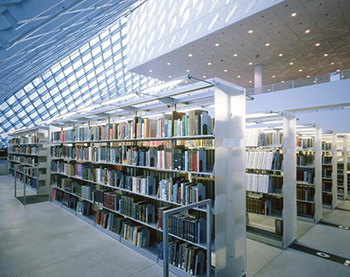 Although individual titles may form its foundation, the modern school or university library is more than a collection of books. It serves as an interactive multimedia center designed to support learning and social cohesion. Thus, careful thought should go into the design and planning of your library. Doing so will maximize the total utility and educational benefit, minimize the need for future improvements, make subsequent expansions easier, and reduce ongoing operations and maintenance costs.
Although individual titles may form its foundation, the modern school or university library is more than a collection of books. It serves as an interactive multimedia center designed to support learning and social cohesion. Thus, careful thought should go into the design and planning of your library. Doing so will maximize the total utility and educational benefit, minimize the need for future improvements, make subsequent expansions easier, and reduce ongoing operations and maintenance costs.
Whether building a new facility from the ground up or remodeling an existing library, the following guidelines will help to better optimize limited resources to fulfill long-term goals.
Design for Accessibility
School and university libraries are inclusive by nature — open all students. Thus, the facility should be accessible to all users, including those with disabilities.
The American Library Association (ALA) has published an online resource to help ensure all collections, entrances, bathrooms and other facilities remain compliant with the Americans with Disabilities Act (ADA). Designing a library with ADA guidelines in mind can reduce the need to duplicate core functions later on. It’s more expensive to add additional bathroom facilities, ramped entrances or handicap-accessible terminals as retrofits.
Internet Connectivity
The facility should be outfitted with Wi-Fi access and plenty of terminals. Students might rely on their school or university library for everything from studying and technical research to blogging or job hunting. If the budget allows, institutions should also include additional power outlets throughout the facility so students can charge their own laptops and devices.
Organization, Shelving and Furniture
Optimizing limited real estate is one of the primary challenges libraries face. In addition to managing ever-increasing collections and daily student traffic, libraries might also host workshops, exhibitions and/or campus events.
Finding the right balance between on-site storage and wide-open spaces can be difficult. Sometimes there are compelling reasons to keep every title on the floor. Movable, modular cabinets can help economize limited real estate in these circumstances. Other times, you may be better off using basement or off-site storage. With this approach, you’ll need to provide searchable access via Internet or Intranet so patrons can retrieve titles remotely.
Whichever strategy you adopt, remember that collections generally grow with time. Plus, future expansions may eventually require investing in modular cabinets or diverting more resources to off-site storage facilities.
Compartmentalization
Although the majority of students and users will use common rooms for reading and studying, you may want to designate certain sections as quiet spaces. This segmentation benefits everyone. Quiet areas, for example, diminish unnecessary disruptions from workshops and general traffic.
Comfort and Aesthetics
There’s a general misconception that library use is on the decline nationwide — mostly as a result of increased Internet use, e-books and mobile devices. However, this notion is largely unfounded. The library’s role has evolved with time. It is increasingly more of a social center than a reference resource.
In effect, the library is a multipurpose facility that for some students serves as an extension of the dorm room or coffee shop. This is especially true for students who might lack access to computers or Internet at home. As such, a library should provide a welcoming environment that offers Internet access, optional food or drink, and close proximity to public transportation — or convenient facilities for parking cars and locking bikes.
Arguably, though, the most important criterion is comfort — i.e. warm lighting, plush seating and clean environments.
Stakeholder Involvement
One of the most important aspects of library planning is feedback. Educators and administrators should obviously remain involved throughout the process. Student and user input will ensure you ask and answer the most vital questions, including the role the library will play and the services deemed most critical to success. Not only will this feedback help you economize limited resources as you move forward with construction and renovation, but it will also make your library a more valuable asset.
Denny Hammack has worked in the storage industry for nearly 30 year. Currently, he is the president of Patterson Pope, a supplier of high-density shelving storage solutions, products and moveable cabinet systems. Learn more at www.pattersonpope.com/sectors/industry/library.

